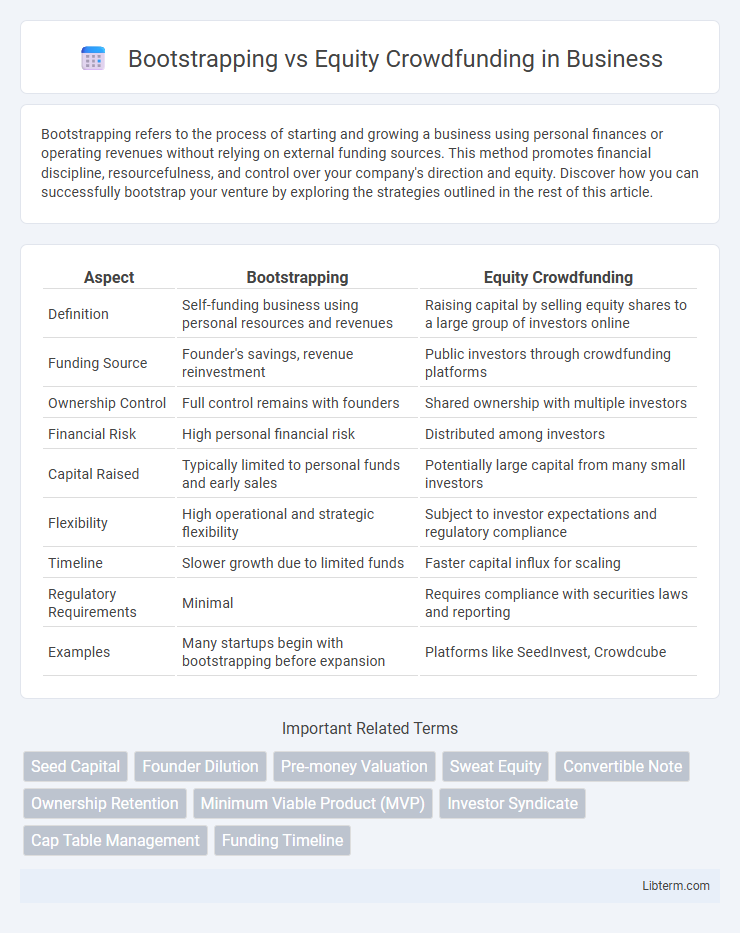Bootstrapping refers to the process of starting and growing a business using personal finances or operating revenues without relying on external funding sources. This method promotes financial discipline, resourcefulness, and control over your company's direction and equity. Discover how you can successfully bootstrap your venture by exploring the strategies outlined in the rest of this article.
Table of Comparison
| Aspect | Bootstrapping | Equity Crowdfunding |
|---|---|---|
| Definition | Self-funding business using personal resources and revenues | Raising capital by selling equity shares to a large group of investors online |
| Funding Source | Founder's savings, revenue reinvestment | Public investors through crowdfunding platforms |
| Ownership Control | Full control remains with founders | Shared ownership with multiple investors |
| Financial Risk | High personal financial risk | Distributed among investors |
| Capital Raised | Typically limited to personal funds and early sales | Potentially large capital from many small investors |
| Flexibility | High operational and strategic flexibility | Subject to investor expectations and regulatory compliance |
| Timeline | Slower growth due to limited funds | Faster capital influx for scaling |
| Regulatory Requirements | Minimal | Requires compliance with securities laws and reporting |
| Examples | Many startups begin with bootstrapping before expansion | Platforms like SeedInvest, Crowdcube |
Introduction to Bootstrapping and Equity Crowdfunding
Bootstrapping involves funding a startup using personal savings, revenue, and minimal external resources, enabling founders to maintain full control and ownership of their business. Equity crowdfunding allows entrepreneurs to raise capital by offering shares to a large pool of investors through online platforms, providing access to substantial investment without traditional venture capital. Both methods have distinct advantages in terms of control, funding scale, and investor involvement, making them key options for early-stage startups.
Key Differences Between Bootstrapping and Equity Crowdfunding
Bootstrapping involves using personal savings or revenue to fund a business, maintaining full ownership and control, while equity crowdfunding raises capital by selling shares to multiple investors, resulting in shared ownership. The key difference lies in financing sources: bootstrapping avoids external debt or equity dilution, whereas equity crowdfunding leverages public investment but requires regulatory compliance and transparent communication with shareholders. Bootstrapping limits growth speed due to capital constraints, whereas equity crowdfunding can accelerate expansion by accessing larger funds from diverse stakeholders.
Pros and Cons of Bootstrapping
Bootstrapping allows entrepreneurs to maintain full ownership and control over their business without diluting equity, fostering self-reliance and efficient resource management. The primary drawback of bootstrapping lies in limited financial resources, which may constrain growth potential and operational scalability. Unlike equity crowdfunding, bootstrapped ventures avoid investor pressure but might face slower market entry and increased personal financial risk.
Advantages and Disadvantages of Equity Crowdfunding
Equity crowdfunding offers startups access to a broad pool of investors, enabling significant capital influx without relying on traditional venture capital or bank loans. It enhances brand visibility and allows companies to leverage investor networks for growth opportunities, but typically involves regulatory compliance, investor management complexity, and potential dilution of ownership. Unlike bootstrapping, equity crowdfunding accelerates funding speed but imposes ongoing obligations to multiple shareholders, which can limit strategic flexibility.
Capital Requirements and Financial Implications
Bootstrapping relies on personal funds and generates capital internally, minimizing external financing costs but limiting scalability and increasing financial risk for founders. Equity crowdfunding involves raising substantial capital from multiple investors, diluting ownership but providing access to larger funding pools and potential marketing benefits. Financial implications of bootstrapping include tighter cash flow management and slower growth, while equity crowdfunding may incur regulatory compliance costs and ongoing investor relations obligations.
Control and Ownership Considerations
Bootstrapping allows entrepreneurs to retain full control and ownership of their business since funding comes from personal savings or revenue, avoiding dilution. Equity crowdfunding involves selling shares to multiple investors, which can dilute existing ownership and require sharing decision-making authority. Founders must weigh the trade-off between maintaining control and accessing larger capital pools through external equity investment.
Risk Factors and Legal Obligations
Bootstrapping minimizes external risk by relying solely on personal funds, avoiding investor obligations but limiting growth potential, while equity crowdfunding involves sharing ownership, exposing founders to dilution and increased fiduciary duties under securities laws. Legal obligations for equity crowdfunding include compliance with SEC regulations, investor disclosures, and ongoing reporting requirements, whereas bootstrapping carries minimal regulatory burdens beyond standard business laws. Evaluating risk factors entails balancing control retention and financial exposure against the legal complexities and capital access provided by equity crowdfunding platforms.
Impact on Business Growth and Scalability
Bootstrapping allows entrepreneurs to retain full control and equity, leading to steady, organic business growth driven by reinvested profits, but may limit scalability due to constrained capital availability. Equity crowdfunding injects substantial external funding, accelerating growth and enabling rapid scalability by accessing a broader investor base, though it dilutes ownership and requires compliance with regulatory frameworks. Businesses seeking aggressive expansion often benefit more from equity crowdfunding's capital infusion, while bootstrapping suits ventures prioritizing control and sustainable development.
Suitable Business Types for Each Funding Method
Bootstrapping suits businesses with low initial capital needs, including service-oriented startups, solopreneurs, and companies focusing on steady organic growth without dilution of ownership. Equity crowdfunding fits scalable ventures, technology startups, and consumer product companies seeking substantial capital to accelerate growth while sharing equity with numerous investors. Selecting the funding method depends on the business model, growth ambitions, and willingness to relinquish equity.
Choosing the Right Funding Strategy for Your Startup
Bootstrapping offers full control and equity retention by relying on personal savings or revenue, ideal for startups prioritizing independence and minimizing external influence. Equity crowdfunding provides access to a larger pool of investors, enabling rapid capital accumulation but requires sharing ownership and adhering to regulatory compliance such as SEC rules for Regulation Crowdfunding. Evaluating factors like growth goals, investor involvement tolerance, and long-term vision helps entrepreneurs select the optimal funding strategy aligned with their startup's financial needs and strategic direction.
Bootstrapping Infographic

 libterm.com
libterm.com